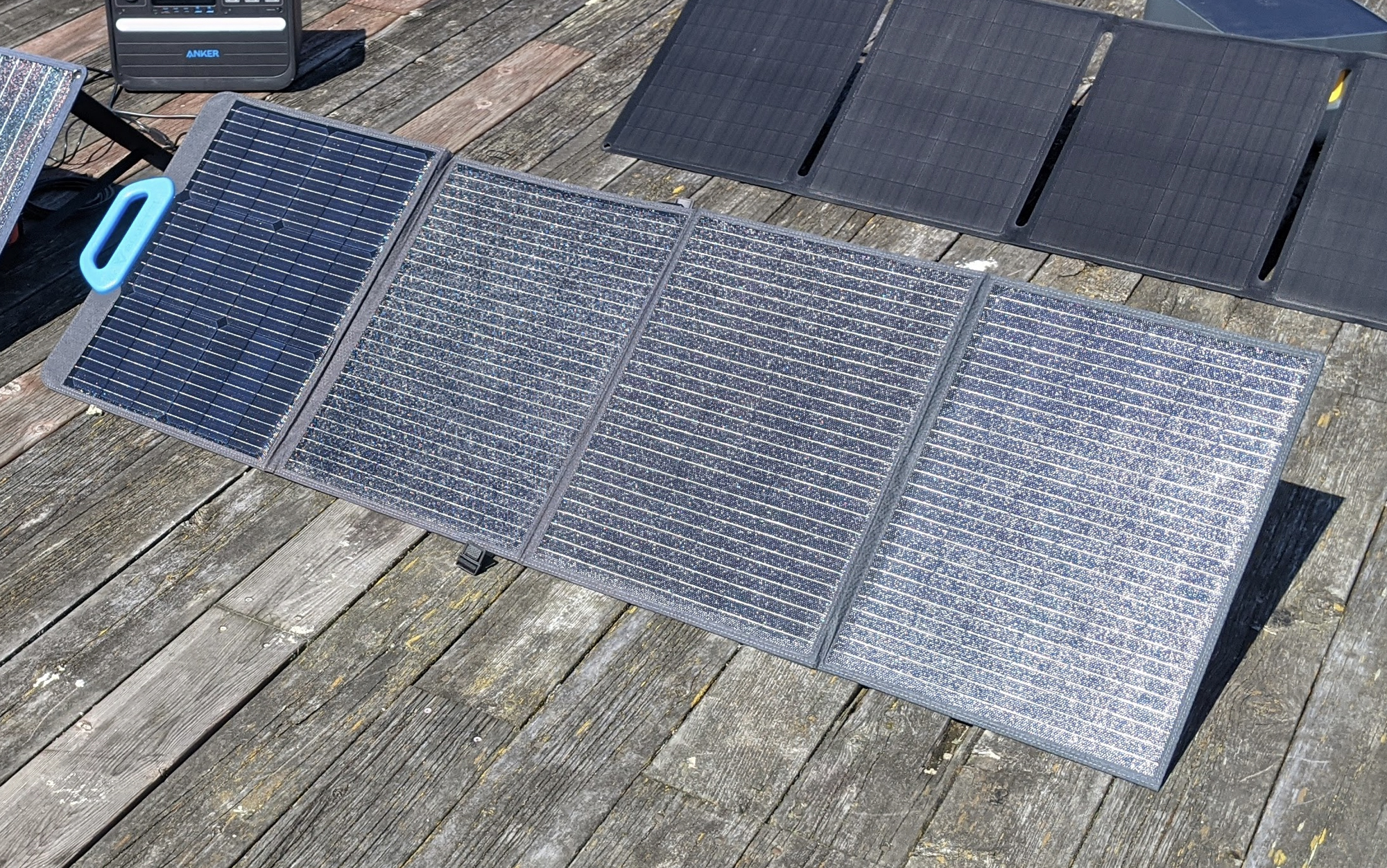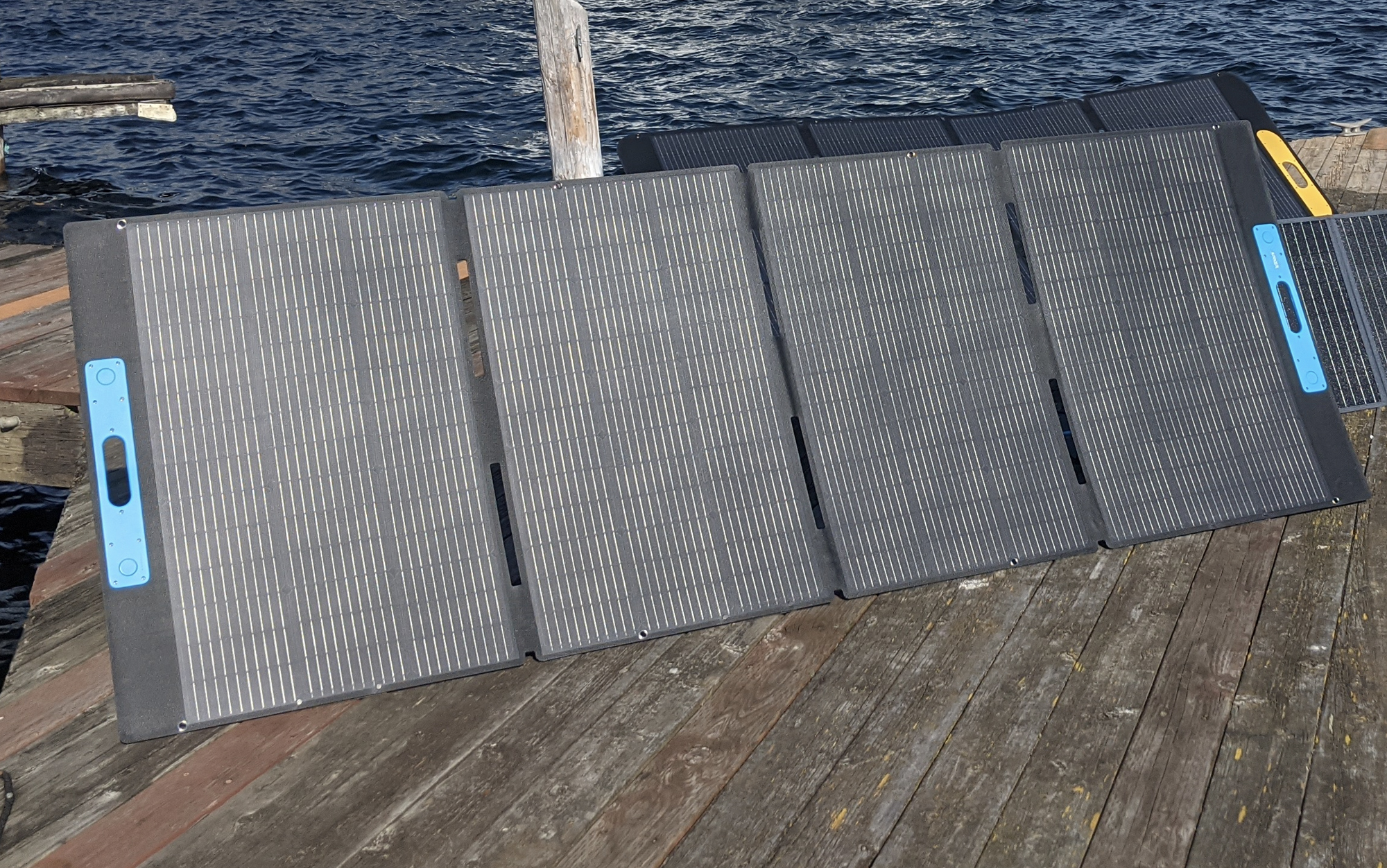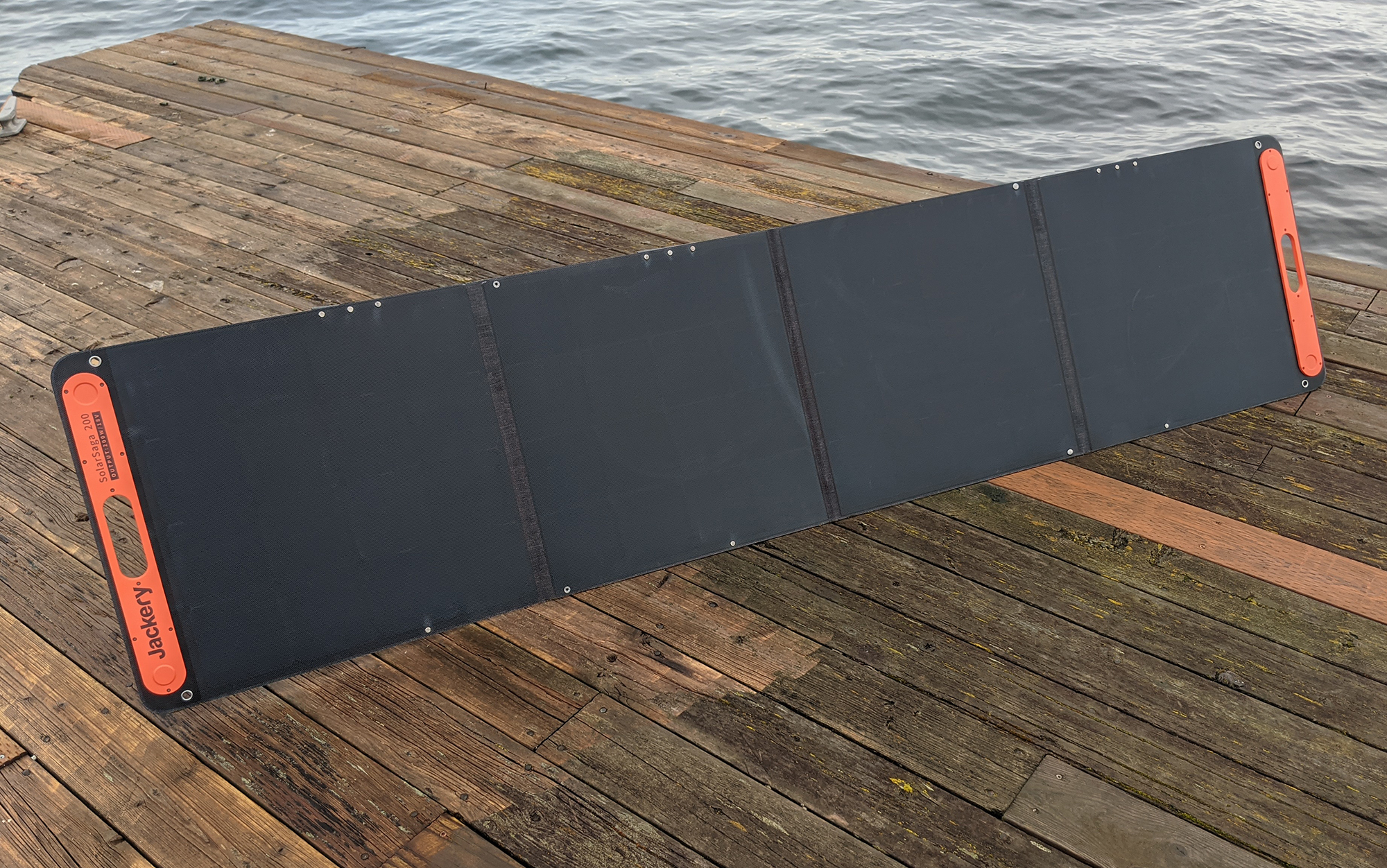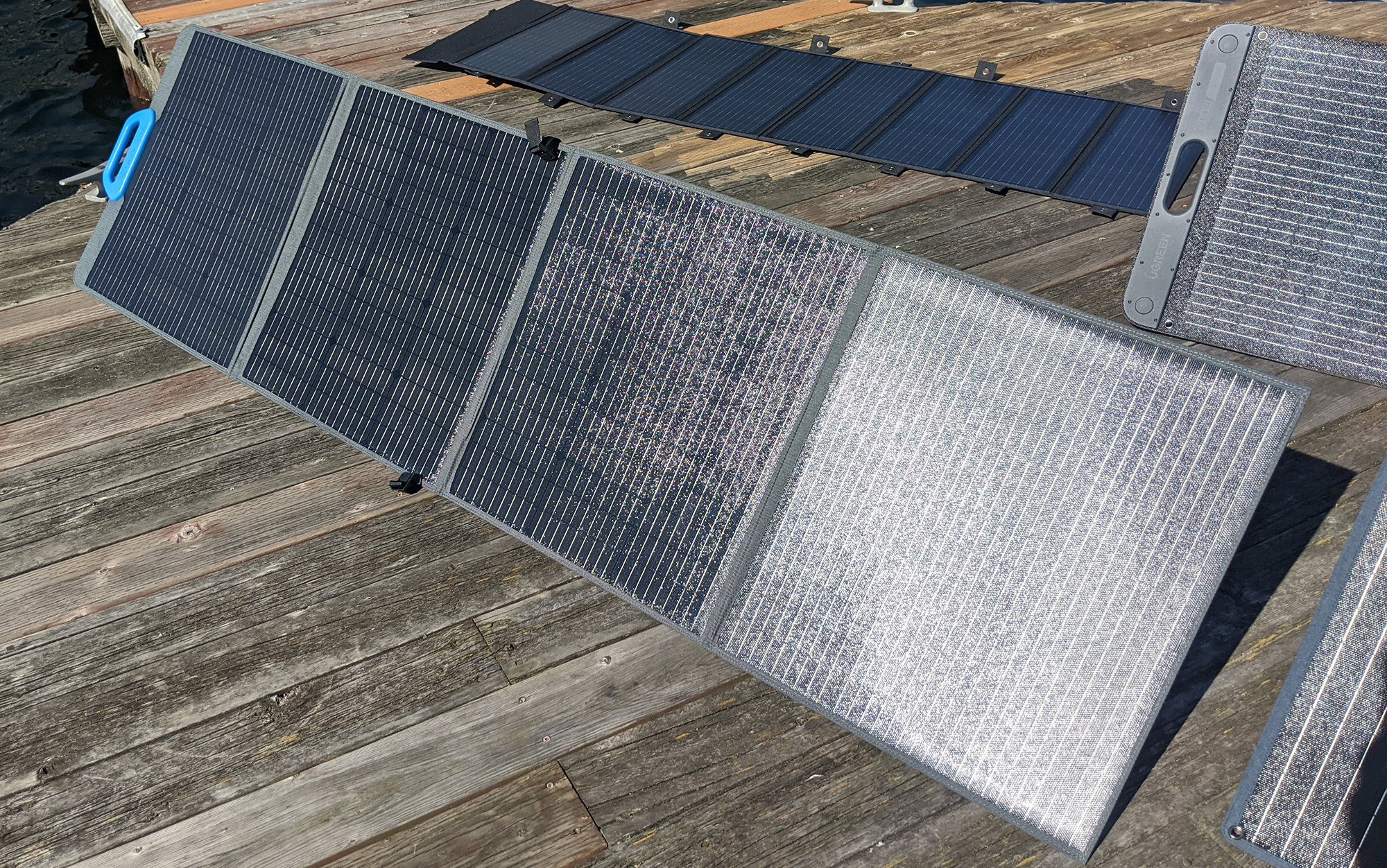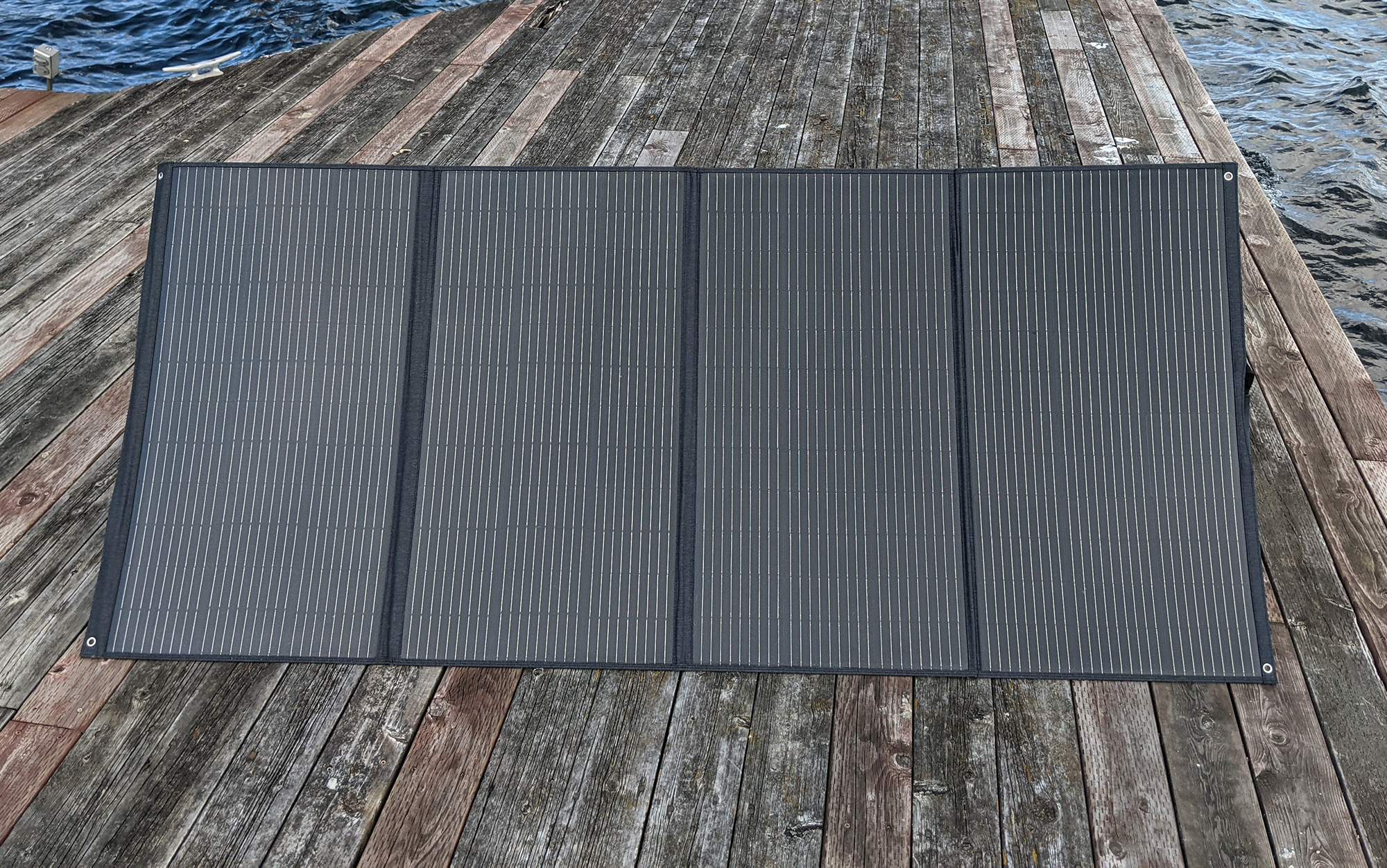The Best Portable Solar Panels of 2024, Tested and Reviewed
We may earn revenue from the products available on this page and participate in affiliate programs. Learn More ›
Best 100W
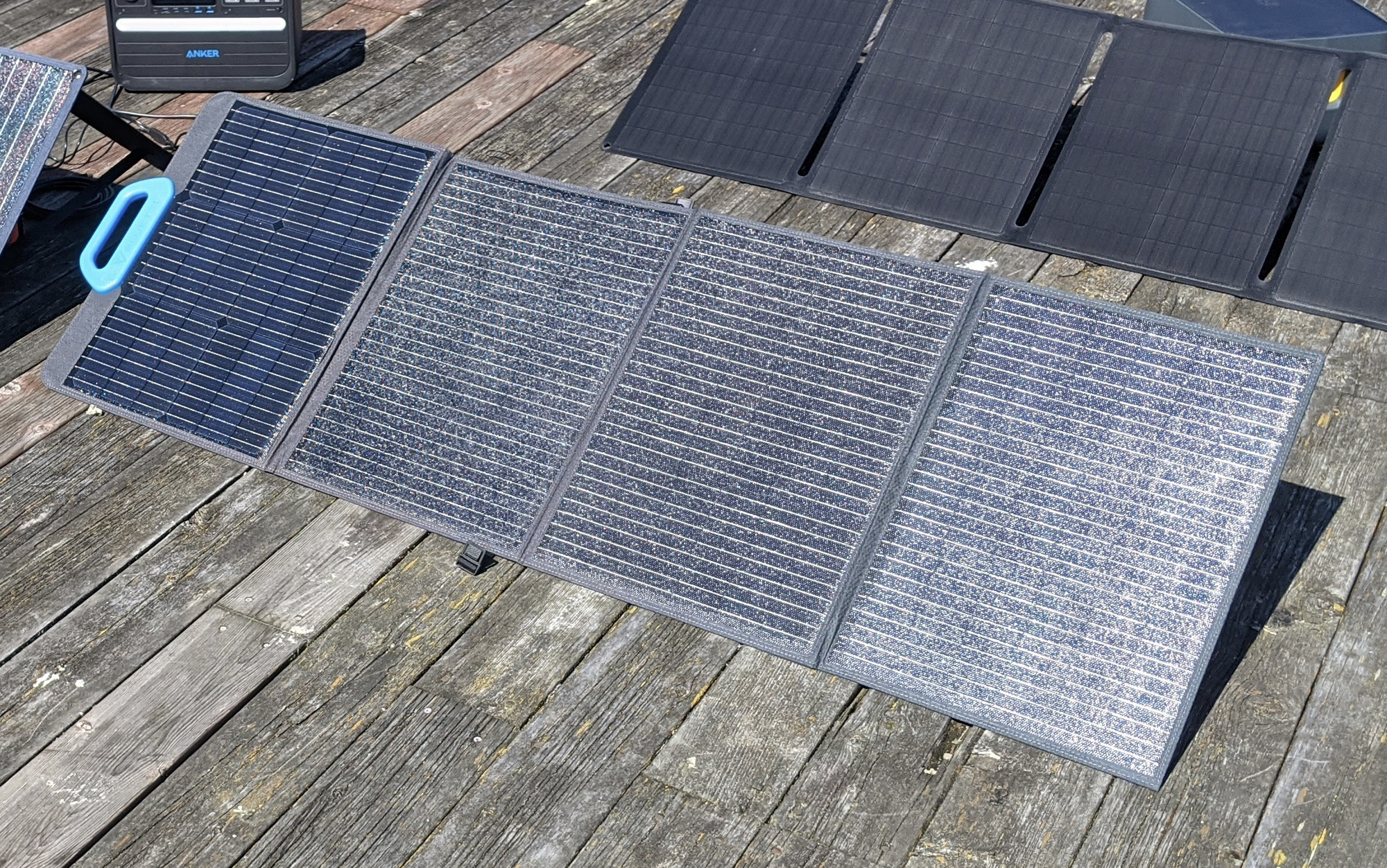
Bluetti PV120
Best 200W

Jackery SolarSaga 200W
Best 400W

Zendure 400W
The sun powers our world, and with the right portable solar panel, it can also power your outdoor adventures or home emergency set up. I’ve tested dozens of models from top brands like Bluetti, Jackery, Anker, Goal Zero, EcoFlow, and BioLite, and have come away impressed with their power generation potential. To help you decide which of the best portable solar panels is right for you, I tested 14 options running from 100W to 400W for power potential, ease of use, and portability.
Topics and Products Covered
- Best 100W: Bluetti PV120
- Best Value 100W: Anker SOLIX 100W
- Best 200W: Jackery SolarSaga 200W
- Best Value 200W: Bluetti PV200
- Best 400W: Zendure 400W
- Best Value 400W: Anker SOLIX 400W
- Rest of the Field
- Full Specs and Test Results
- Things to Consider Before Buying a Portable Solar Panel
- FAQs
If you’re looking to purchase both a power station and portable solar panel, check out my take on the best solar generators; It looks at which pairings provide the best bang for your buck.
How I Tested the Best Portable Solar Panels
My solar panel testing consisted of three criteria: performance (measured power output), portability, and ease of use. I also considered other factors like price, warranty, and IP rating (a third-party test that looks at dustproofness and waterproofness). I focused this review on the solar panels between 100W and 400W and tested panels from Jackery, Bluetti, EcoFlow, Anker, Goal Zero, Dakota Lithium, Vtoman, Zendure, Ugreen, BioLite, and Lion Energy.
Testing Power Generation
Performance was tested twice: on a clear day and on a cloudy day. I used the best portable power stations to measure the solar energy generated by each panel and used the Anker SOLIX 100W panel as my control panel to account for inconsistent conditions between tests. I used the attached sundial on the Anker SOLIX 100W to ensure the panels were always optimally oriented toward the sun. Then I took a reading from each panel, adjusting the results as necessary based on the reading of the control panel.
Testing the Portable Solar Panels’ Ease of Use
Ease of use was assessed by looking at how easy or difficult it was to set up each panel. Some portable solar panels had adjustable legs or sundials that made them quick and easy to use —- these were ranked as Excellent. Others toppled over easily, refused to lie flat, or had complicated setups. Those were rated Poor.
Testing Portability
How portable a solar panel is depends in large part on its physical size. 400W solar panels are a lot harder to lug around than 100W solar panels, and they won’t fit as easily in your car or on a garage shelf. Even given that, I was surprised at how much variability there is in features such as handles, cable storage, and latching mechanisms. I moved each solar panel up and down multiple flights of stairs and out to my testing site over several days, giving me ample insight into how portable each unit is.
Grading
While the above criteria is how I graded each of the best portable solar panels, there is one more factor that should inform your choice: compatibility with your portable power station. There are two things you need to check: load compatibility and port compatibility. For load compatibility, check that both the volts and the wattage supplied by the solar panel won’t overload your power station. I’ve listed the specs for each solar panel in this test, and you can typically find the information for your power station in very small font on the bottom of the unit.
For port compatibility, you simply want to look at whether the cord coming out of the solar panel can be connected to the power station you are purchasing. Unfortunately, different brands use different cords, and some brands even use different cords within their lineup, which is all very frustrating. In some instances, you may be able to purchase an adapter cord if the provided cable for the solar panel doesn’t match the ports on your power station. Goal Zero has a number of cables to convert mismatched ports and plugs that can help get you started.
Best Portable Solar Panels: Reviews & Recommendations.
Best 100W: Bluetti PV120
Report Card
- Full Sun: 110W (92% of claimed 120W potential)
- Clouds: 25W (21% of claimed 120W potential)
- Portability: Excellent
- Ease of Use: Great
Key Features
- Weight: 13 pounds
- Packed Size: 21 x 19 inches
- Output Ports: DC
- Rated Voltage: 20V
- IP Rating: IP 65
- Lowest Operating Temp: 14 F
- Warranty: 1 year
Pros
- Best power generation of all the portable power stations at its price point
- Packs up securely
- Comfortable to carry
Cons
- No sundial feature
The Bluetti PV120 bills itself as 120 watt capable, but it’s about the same size and, more importantly, price of all the other 100-watt panels, so we’re grouping it here. And in its size category, the Bluetti PV120 is far and away the best performer, producing well over 100 watts in full sun while beating out the competition in shady conditions. It’s exceptionally portable, with a comfortable handle, an accordion shape that clips together so it won’t come apart while you’re walking. I also appreciate the handy storage bag for its cable, so that you don’t misplace it when not in use. Trust me, I misplaced plenty of charging cables while testing the best portable solar panels and being able to pack away the charging cable with the solar panel itself is very helpful.
The smaller sized solar panels are all easier to set up than the larger 200W and 400W models, but even within these, the Bluetti PV120 stood out as being easy to use. It has the right number of kickstand legs in the right places, and you can securely adjust the angle using snap buttons on the back of the legs.
Best Value 100W: Anker SOLIX 100W
Report Card
- Full Sun: 94W (94% of claimed 100W potential)
- Clouds: 22W (22% of claimed 100W potential)
- Portability: Excellent
- Ease of Use: Excellent
Key Features
- Weight: 11 pounds
- Packed Size: 21 x 19 inches
- Output Ports: XT-60
- Rated Voltage: 27V
- IP Rating: N/A
- Lowest Operating Temp: -4 F
- Warranty: 2 years
Pros
- Strong performance in sun and clouds
- Sundial feature!
Cons
- Not as easy to adjust as the Bluetti PV120
The Anker SOLIX 100W (formerly the 625 model) has been my control panel for every round of testing I’ve done over the last two years of the best portable solar panels. The reason for that is the sundial feature. It is hard to overstate what a useful feature this is. Whereas with other panels you’re left guessing if you’ve got it angled correctly toward the sun, which leaves you adjusting it while you watch the wattage meter on your portable power station go up or down.
With the Anker SOLIX 100W it’s easy to see which direction you need to tilt the panel to ensure the dot shadow is inside the bull’s eye. This makes a surprisingly big difference — even with the 100W panels we’re talking a 10W or more difference in power generation for minor adjustments. I do not understand why other solar panels don’t have this feature (the only others I’ve tested that have it are the BioLite 100W and the Ugreen 200W).
Unfortunately for the Anker SOLIX 100W, it’s not as easy to adjust the kickstand legs as the Bluetti PV120, and it didn’t have quite the same power potential (although still beating out the others in the 100W range). But for the built-in sundial feature alone it’s more than worth your money.
Best 200W: Jackery SolarSaga 200W
Report Card
- Full Sun: 184 (92% of claimed 200W potential)
- Clouds: 49 (25% of claimed 200W potential)
- Portability: Great
- Ease of Use: Great
Key Features
- Weight: 14 pounds
- Packed Size: 24 x 21 inches
- Output Ports: DC
- Rated Voltage: 20V
- IP Rating: IP 68
- Lowest Operating Temp: -4 F
- Warranty: 3 years
Pros
- Best performance in the cloudy weather test, second best performance in sunny weather
- Lightweight
- Good warranty
Cons
- Expensive
- No sundial feature
If money is no object then you would be hard pressed to do better than the Jackery SolarSaga 200W. I’ve been consistently impressed by the performance of this panel in all manner of conditions, from sun to clouds — I’ve even seen it generate power in total shade with dusk approaching. It’s plenty easy to set up; It’s plenty easy to transport. It’s the total package. It would be nice if the kickstand legs could be adjusted more securely, like with the Bluetti and Anker 200W solar panels, but it’s never been an issue for me in practice given the wide design and springiness of the elastic holding the legs in place. The only real catch is the price, which is hundreds of dollars more than my best value pick. Try to find this one on sale if at all possible.
Best Value 200W: Bluetti PV200
Report Card
- Full Sun: 178W (89% of claimed 200W potential)
- Clouds: 44 (22% of claimed 200W potential)
- Portability: Great
- Ease of Use: Excellent
Key Features
- Weight: 19 pounds
- Packed Size: 25 x 23 inches
- Output Ports: MC4
- Rated Voltage: 21V
- IP Rating: IP 65
- Lowest Operating Temp: 14 F
- Warranty: 1 year
Pros
- Adjustable legs are easy to use
- Excellent power generation in both sun and clouds
- MC4 connector is easier to mix and match than others
Cons
- Shorter warranty than others on this list
- No sundial feature
This solar panel is an excellent value. You get pretty darn close to the power generation potential of the Jackery SolarSaga 200W — in both sun and clouds — and you pay about a third less. I particularly like its setup, including the snap buttons on the kickstand legs that you can use to adjust the angle of the panel. The carrying case design is also top notch, with a comfortable handle and zippered pouch for its cable. The snaps that hold the panels in place when folded up are also a nice tough.
I don’t love the warranty on this — one year is awfully short or a product that realistically should last a decade or more. But that’s my only gripe. After a year of using and abusing the 120W version of this panel, I haven’t run into any durability issues with this series yet.
Best 400W: Zendure 400W
Report Card
- Full Sun: 359W (90% of claimed 400W potential)
- Portability: Good
- Ease of Use: Great
Key Features
- Weight: 30 pounds
- Packed Size: 39 x 22 inches
- Output Ports: XT-90
- Rated Voltage: 40V
- IP Rating: IP 54
- Lowest Operating Temp: 14 F
- Warranty: 2 years
Pros
- Largest power potential in my test
- Lighter than other 400W panels I looked at
Cons
- Expensive
- Not compatible with standard portable power stations
- No sundial feature
Watt for watt, the Zendure 400W solar panel has exceptionally good performance. In ideal weather conditions, I’ve seen it generate over 400 watts of power at a time. It’s also surprisingly lightweight, easy to transport, and, for a larger solar panel, wasn’t particularly onerous to set up. I did not, however, keep it in my arsenal after my initial test (in conjunction with my appraisal of the Zendure SuperBase) due to its large size and lack of compatibility, and thus was unable to perform a test in cloudy weather conditions.
The Zendure 400W comes with an XT-90 cable. That means it’s not compatible with any power station in my test of the best portable power stations; in fact, the only power station I’ve ever tested that it is compatible with is the Zendure SuperBase, a power station that was not what I would call “portable,” given that it weighed nearly as much as I do. While the stated voltage output of the Zendure 400W is such that it should be possible to convert it to a different connector style (like an XT-60) with an adaptor, I have not tested this so cannot speak to whether a loss in amps would affect the power output potential.
The other catch to the Zendure 400W is that it’s pricey, a whopping $500 more than my best value pick.
Best Value 400W: Anker SOLIX 400W
Report Card
- Full Sun: 330W (83% of claimed 400W potential)
- Clouds: 77W (19% of claimed 400W potential)
- Portability: Fair
- Ease of Use: Good
Key Features
- Weight: 35 pounds
- Packed Size: 39 x 26 inches
- Output Ports: XT-60
- Rated Voltage: 48V
- IP Rating: IP 67
- Lowest Operating Temp: -4F
- Warranty: 2 years
Pros
- Lowest price of all the 400W panels I looked at
- Comparatively easy set up
Cons
- Less power output than expected in cloudy weather
- Uncomfortable handle and no pocket for cable storage
- No sundial feature
This one was closer than I was expecting. The Vtoman 400W solar panel, despite being heavier, was easier to transport due to its better handle design and the zip pocket for the cable. It also had a better performance in cloudy weather than the Anker SOLIX 400W.
A look at the adjustable kickstand legs of the Anker SOLIX 400W
But the Anker SOLIX 400W had a strong showing in full sun, was a couple hundred dollars less expensive, and was miles easier to set up. The Vtoman 400W has floppy kickstand legs that are difficult to get into position. The Anker SOLIX 400W has adjustable legs that made it fairly simple to get what would otherwise be an unwieldy panel set to the right angle for optimal power generation. Given how important it is to adjust the angle of your solar panel regularly to maximize power potential, this is an important detail that puts the Anker SOLIX in the top spot for value.
The Rest of the Field
While the Vtoman 400W solar panel had one of the worst setups of any portable solar panel I tested (giant panel plus floppy legs is a bad combo), it did come with my all-time favorite cable. This one can be paired, out of the box, with the widest array of power stations. While there is some danger with mixing and matching solar panels and power stations (Goal Zero has told me that they discourage it with their products), for individuals confident that they can assess the power potential and capabilities of various power stations, this could be an interesting choice.
While I’m a big fan of EcoFlow’s portable power stations (their Delta 2 was my best overall pick in that test), I find their solar panels unnecessarily fussy. First off, they don’t have kickstands. Instead you’re meant to attach the panel to the four corners of the carrying case, and then adjust the angle by zipping or unzipping the case. This more or less works, but is ridiculously fiddly.
Second, this panel, when stored for long periods of time, can start to warp such that I have found it difficult to fully flatten out. As a result, I think you’re better off skipping these units, despite their impressive power potential. The only exception to this is if you are specifically looking for a panel that can generate power on both sides — in my testing, it typically can produce half the volume of power on the opposite side, which is an interesting feature.
I similarly find there to be a pretty major discrepancy between my experience of Goal Zero’s portable power stations and their portable solar panels. Their Boulder series, while somewhat more affordable, is heavy and clunky for the amount of power it produces and you can’t adjust the angle to match the sun. I was optimistic that the more lightweight Nomad 200W would improve on the experience but I was, unfortunately, unable to complete testing due to the incompatibility of its charging cables with the Goal Zero unit I have on hand.
While the cloudy weather testing result was quite impressive, the sun has disappeared from these PNW skies for the foreseeable future (I will update this review with the results of the blue sky testing at a later date). Also frustrating was the lack of a carrying handle on the case, a detail that made it surprisingly awkward to carry. When I queried Goal Zero, they reported that their solar panels will operate down to -40° F, far and away the lowest claimed temperature in my test.
The Dakota Lithium 180 got surprisingly high marks for portability but was ultimately not powerful enough compared to other panels at that price point and lower. It also eschewed kickstands in favor of tie-off loops which was fine, but I would have preferred the kickstands to achieve maximum solar input. But the unique accordion shape of the panel made it, by far, the most portable solar panel in my test.
A few panels that impressed on portability and ease of use but failed to deliver the power others were capable of included the BioLite 100W, and the Ugreen 100W. The Lion Energy did impress during testing (it also stood out as one of the few solar panels that didn’t look like it had been produced in a mono manufacturing facility), but didn’t quite make the cut for one of the above awards.
Full Specs and Test Results for the Best Portable Solar Panels
100W Solar Panel Specs
| Model | Price | Warranty | Size (folded) | Size (unfolded) | Output Ports | Rated Voltage |
| Bluetti PV120 | $300 | 1 year | 21 x 18.5 inches | 21 x 65 inches | DC | 20V |
| Goal Zero Boulder 100W | $250 | 2 years | 40 x 27 inches | 40 x 27 inches | High Power Port (HPP) | 23V |
| Anker SOLIX 100W | $330 | 2 years | 21 x 19 inches | 57 x 21 inches | XT-60 | 27V |
| BioLite Solar Panel 100 | $400 | 1 year | 20 x 14 inches | 20 x 58 inches | High Power Port (HPP) | 20V |
| Lion Energy 100W LW 12V | $300 | 5 years | 27 x 20 inches | 40 x 27 inches | High Power Port (HPP) | 18V |
| EcoFlow 110 W | $400 | 1 year | 20 x 17 inches | 63 x 20 inches | MC4 | 19V |
100W Solar Panel Performance
| Model | Price | Weight | IP Rating | Lowest Operating Temp | Rated Power | Measured Power (Sun) | Measured Power (Clouds) | Portability | Ease of Use |
| Bluetti PV120 | $300 | 13 pounds | IP 65 | 14 F | 120W | 110W | 25W | Excellent | Great |
| Goal Zero Boulder 100W | $250 | 20 pounds | IP65 | -40 F | 100W | 73W | – | Fair | Fair |
| Anker SOLIX 100W | $300 | 11 pounds | TK | -4 F | 100W | 94W | 22W | Excellent | Excellent |
| BioLite Solar Panel 100 | $400 | 10 pounds | IPX4 | TK | 100W | 70W | – | Excellent | Great |
| Lion Energy 100W LW 12V | $300 | 22 pounds | None | N/A | 100W | 88W | 18W | Excellent | Excellent |
| EcoFlow 110 W | $400 | 9 pounds | IP 68 | -4 F | 110W | 104W | 21W | Excellent | Poor |
200W Solar Panel Specs
| Model | Price | Warranty | Size (folded) | Size (unfolded) | Output Ports | Rated Voltage |
| EcoFlow 220W Bifacial | $650 | 1 year | 33 x 20 inches | 72 x 32 inches | XT-60 | 22V |
| Jackery SolarSaga 200W | $700 | 3 years | 24 x 21 inches | 91 x 21 inches | DC8020 (8.1mm DC) and DC7909 (8MM DC) | 20V |
| Goal Zero Boulder 200W | $550 | 2 years | 40 x 27 inches | 40 x 54 inches | High Power Port (HPP) | 22V |
| Anker SOLIX 200W | $500 | 2 years | 24 x 22 inches | 84 x 24 inches | XT-60 | 48V |
| Dakota Lithium Solar 180 | $700 | 11 years | 24 x 9 inches | 78 x 24 inches | MC4 | 21V |
| Goal Zero Nomad 200 | $500 | 2 years | 28 x 22 inches | 101 x 18 inches | HPP | 19V |
| Bluetti PV200 | $500 | 1 year | 25 x 23 inches | 89 x 23 inches | MC4 | 21V |
| Ugreen 200W | $500 | 2 years | 25 x 21 inches | 94 x 21 inches | XT-60 | 19V |
200W Solar Panel Performance
| Model | Price | Weight | IP Rating | Lowest Operating Temp | Rated Power | Measured Power (Sun) | Measured Power (Clouds | Portability | Ease of Use |
| EcoFlow 220W Bifacial | $650 | 21 pounds | IP68 | -4 F | 220W | 197W | 46W | Great | Poor |
| Jackery SolarSaga 200W | $700 | 14 pounds | IP68 | -4 F | 200W | 184W | 49W | Great | Great |
| Goal Zero Boulder 200W | $550 | 42 pounds | IP65 | -40 F | 200W | 145W | – | Poor | Good |
| Anker SOLIX 200W | $500 | 20 pounds | IP67 | -4 F | 200W | 158W | 42W | Great | Excellent |
| Dakota Lithium Solar 180 | $700 | 10.5 pounds | TK | TK | 180W | 86W | 30W | Excellent | Fair |
| Goal Zero Nomad 200 | $500 | 22 pounds | IP65 | -40 F | 200W | – | 66W | Poor | Good |
| Bluetti PV200 | $500 | 16 pounds | IP65 | 14 F | 200W | 178W | 44W | Great | Excellent |
| Ugreen 200W | $500 | 19 pounds | 14 F | 200W | 127W | 30W | Great | Great |
400W Solar Panel Specs
| Model | Price | Warranty | Size (folded) | Size (unfolded) | Output Ports | Rated Voltage |
| Zendure 400W | $1400 | 3 years | 39 x 22 inches | 88 x 39 inches | XT-90 | 40V |
| Anker SOLIX 400W | $900 | 2 years | 36 x 26 inches | 102 x 36 inches | XT-60 | 48V |
| Vtoman 400W | $1100 | 2 years | 42 x 26 inches | 95 x 42 inches | Anderson, XT-60, and DC5521 | 40V |
400W Solar Panel Performance
| Model | Price | Weight | IP Rating | Lowest Operating Temp | Rated Power | Measured Power (Sun) | Measured Power (Clouds) | Portability | Ease of Use |
| Zendure 400W | $1400 | 30 pounds | IP54 | 14 F | 400W | 359W | – | Good | Great |
| Anker SOLIX 400W | $900 | 35 pounds | IP67 | -4 F | 400W | 330W | 77W | Fair | Good |
| Vtoman 400W | $1100 | 38 pounds | IP67 | 4 F | 400W | 295W | 84W | Good | Fair |
Things to Consider Before Buying a Portable Solar Panel
Power Station Compatibility
All of the portable solar panels in this test must be paired with one of the best portable power stations. While there are some solar chargers that include ports for a classic USB-A or USB-C cable, the ones in this test are producing so much power that this is not an effective way to capture it — if they went full throttle at your phone they would fry it. So you need an intermediary to hold the power and release it in a controlled way.
There are two specs to check for when looking to see if your portable solar panel is compatible with your portable power station: power potential and connector/port compatibility.
Power Potential Compatibility
Solar panels aren’t all that smart. Whatever blast of sun they are getting will be transmitted directly as power to your power station. So before you purchase a portable solar panel, first look at your power station to see how much solar input it can handle. (This is typically found in very small font on the bottom of your power station). Don’t purchase a solar panel or solar panels that exceeds this power potential, as it can damage the battery in your power station.
Solar Panel Connector and Power Station Port Compatibility
In the same way that you can’t plug a USB-C charging cord into a lightning port, not all solar panel cable connectors are compatible with every power station port. The most common ones I’ve seen while testing are 8mm DC, XT60, HPP (High Power Port). While you can in some cases find an adaptor cord so that you can use a solar panel with an 8mm charging cable with a power station with an XT60 port, this is a bit of pain.
Power Potential
Once you’ve locked in on which portable solar panels are compatible with your current power station, the next major question to ask is how much power you want to generate. Generally, larger solar panels generate more power than smaller solar panels, but are unwieldy to transport and set up. The above tables drill down more on which solar panels in testing produced the most power in full sun.
Portability and Ease of Set Up
While several of the solar panels I tested seemed to be made in the same manufacturing plant — same colors and fabrics, similar design choices — there was still some surprising variability in ease of set up and portability. Generally, the largest solar panels were the most difficult to move and set up, and the smaller ones the easiest, but details like handle comfort and number of kickstands made a surprising difference in the overall experience.
FAQs
It’s a lot of fun to own a portable solar panel. Charging up your phone or your laptop with nothing more than the power of the sun is pretty satisfying, and it can give you some peace of mind in the event of a power outage. For some people, it can supplement one of the best portable power stations as part of their at-home emergency kits. For others, it can extend the length of time they are able to be off-grid with an overlanding setup. Typically, though, whether or not a portable solar panel is worth it depends in large part on how much sun the area you are in gets.
I was impressed to see that the best portable solar panels really do produce the amount of power they say they do. If you live in a sunny part of the country, you can be confident that the wattage stated on the solar panel is more or less the wattage that you will get — assuming you get the panel oriented for optimal efficiency. I recommend purchasing a sundial to clip onto your solar panel so that you can be sure it’s angled directly at the sun.
The size solar panel you need depends on a few factors, including how much energy your power station can accept from a solar panel, how much power you are hoping to generate, and how important portability is to you.
Final Thoughts
The best portable solar panels on this list are all excellent choices for pairing with the best portable power stations. If you do decide to mix and match brands and models, double check that the cable requirements and voltage capabilities match up first.
- Best 100W: Bluetti PV120
- Best Value 100W: Anker SOLIX 100W
- Best 200W: Jackery SolarSaga 200W
- Best Value 200W: Bluetti PV200
- Best 400W: Zendure 400W
- Best Value 400W: Anker SOLIX 400W
The post The Best Portable Solar Panels of 2024, Tested and Reviewed appeared first on Outdoor Life.
Source: https://www.outdoorlife.com/gear/best-portable-solar-panels/

